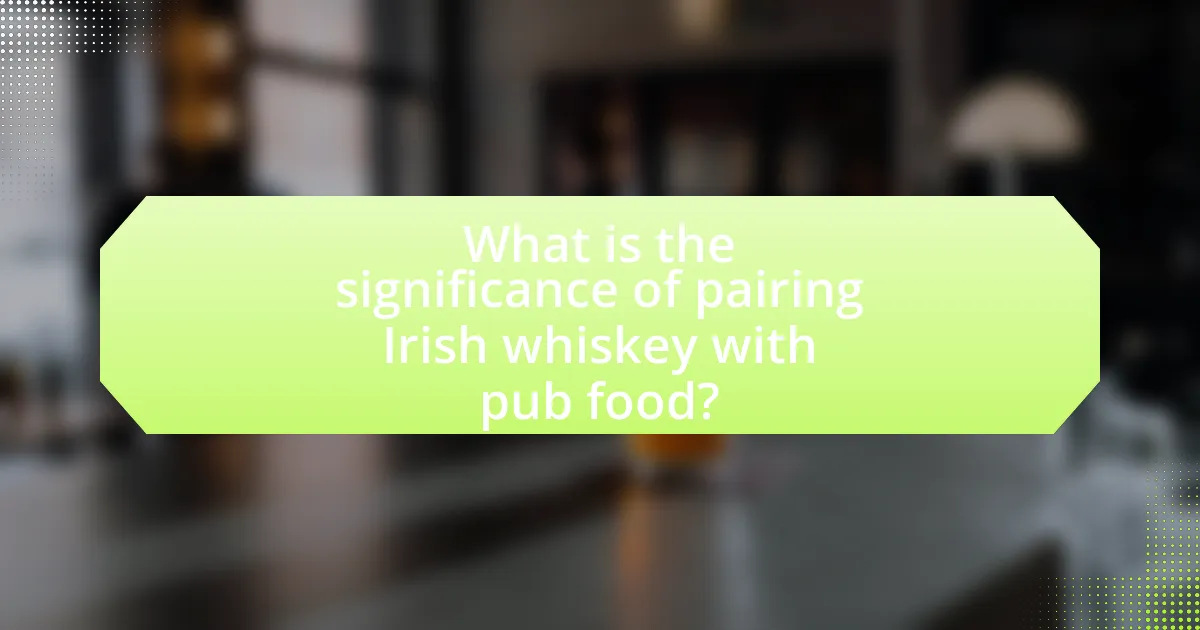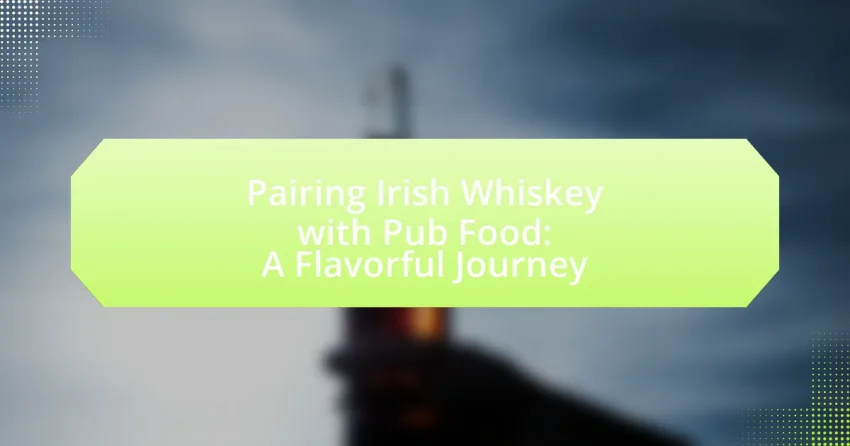The article focuses on the significance of pairing Irish whiskey with pub food, highlighting how the smooth and rich flavor profile of Irish whiskey enhances traditional dishes. It discusses the key flavor notes in Irish whiskey, such as sweetness and spice, and how these interact with common pub food ingredients. The article also explores the cultural and historical context of this pairing tradition, emphasizing its role in Irish culinary heritage. Additionally, it provides specific recommendations for whiskey and food pairings, including popular combinations and tips for enhancing the tasting experience.

What is the significance of pairing Irish whiskey with pub food?
Pairing Irish whiskey with pub food enhances the overall dining experience by complementing flavors and textures. The smooth, rich profile of Irish whiskey, often characterized by notes of vanilla, caramel, and fruit, contrasts well with the savory and hearty nature of traditional pub dishes like stews, fried foods, and grilled meats. This combination not only elevates the taste of the food but also creates a harmonious balance that can enhance the enjoyment of both the whiskey and the meal. Historical practices in Irish pubs have shown that this pairing tradition fosters social interaction and cultural appreciation, making it a significant aspect of Irish culinary heritage.
How does the flavor profile of Irish whiskey complement pub food?
The flavor profile of Irish whiskey complements pub food through its smoothness, light sweetness, and subtle spice, which enhance the savory and hearty characteristics of traditional dishes. The smooth texture of Irish whiskey, often attributed to triple distillation, allows it to pair well with rich foods like shepherd’s pie and fish and chips, balancing their flavors without overwhelming them. Additionally, the light sweetness from the malt and grain used in production complements salty snacks such as pretzels and fried foods, while the gentle spice notes can elevate the taste of grilled meats and stews. This harmonious interaction between the whiskey’s profile and the diverse flavors of pub food creates a satisfying dining experience.
What are the key flavor notes in Irish whiskey?
The key flavor notes in Irish whiskey include smooth sweetness, light fruitiness, and a hint of spice. These characteristics arise from the triple distillation process, which results in a smoother spirit, and the use of unmalted barley, contributing to the whiskey’s sweet and fruity profile. Additionally, aging in a variety of cask types, such as bourbon and sherry, enhances the complexity with notes of vanilla, honey, and dried fruits, making Irish whiskey distinctively approachable and versatile for pairing with pub food.
How do these flavor notes interact with common pub food ingredients?
Flavor notes in Irish whiskey, such as caramel, vanilla, and spice, interact harmoniously with common pub food ingredients like fried potatoes, cheese, and meats. The sweetness from caramel and vanilla complements the saltiness of fried foods, enhancing their flavor profile. For instance, pairing whiskey with cheese, particularly sharp varieties, allows the spice notes to cut through the richness, creating a balanced taste experience. Additionally, the warmth of spice in whiskey can elevate the savory flavors of grilled meats, making the combination more satisfying. This interaction is supported by the principle of flavor synergy, where contrasting and complementary flavors enhance overall enjoyment.
Why is Irish whiskey a popular choice in pubs?
Irish whiskey is a popular choice in pubs due to its smooth flavor profile and versatility in pairing with various foods. The triple distillation process used in Irish whiskey production results in a lighter, smoother spirit compared to other whiskeys, making it more approachable for a wider audience. Additionally, its flavor notes, which often include hints of vanilla, honey, and fruit, complement traditional pub fare such as hearty stews and fried foods. This compatibility enhances the overall dining experience, contributing to its popularity in social settings.
What cultural factors influence the pairing of Irish whiskey and pub food?
Cultural factors influencing the pairing of Irish whiskey and pub food include traditional Irish hospitality, the significance of communal dining, and the historical context of whiskey production in Ireland. Traditional Irish hospitality emphasizes sharing food and drink, fostering a social atmosphere where whiskey complements hearty pub fare. The communal aspect of dining in Irish culture encourages pairing whiskey with dishes like stew or fish and chips, enhancing the overall experience. Additionally, the historical significance of whiskey, which dates back to the 12th century in Ireland, has led to a deep-rooted appreciation for its flavors, making it a natural accompaniment to the robust flavors of pub food.
How does the history of Irish whiskey contribute to its pairing with food?
The history of Irish whiskey significantly contributes to its pairing with food by establishing a rich tradition of craftsmanship and flavor profiles that complement various dishes. Irish whiskey, known for its smoothness and triple distillation process, has evolved alongside Irish culinary practices, leading to pairings that enhance both the drink and the food. For instance, the use of ingredients like barley and the influence of local terroir in whiskey production have historically aligned with traditional Irish fare, such as stews and seafood, creating harmonious flavor experiences. This historical context underscores the importance of regional ingredients and culinary heritage, making Irish whiskey a versatile companion to a wide range of pub foods.

What are the best Irish whiskey and pub food pairings?
The best Irish whiskey and pub food pairings include Jameson with fish and chips, Redbreast with beef and Guinness stew, and Bushmills with shepherd’s pie. Jameson’s smoothness complements the crispy batter and flaky fish, enhancing the overall flavor experience. Redbreast, known for its rich and complex profile, pairs well with the hearty beef and Guinness stew, as the whiskey’s fruitiness balances the dish’s richness. Bushmills, with its lighter, honeyed notes, matches the savory flavors of shepherd’s pie, creating a harmonious blend of tastes. These pairings are rooted in traditional Irish culinary practices, where whiskey enhances the enjoyment of classic pub dishes.
Which types of Irish whiskey are best suited for pub food?
The types of Irish whiskey best suited for pub food include blended Irish whiskey, single pot still whiskey, and single malt whiskey. Blended Irish whiskey, such as Jameson, offers a smooth and versatile profile that complements a variety of dishes, making it ideal for pairing with hearty pub fare like burgers and fish and chips. Single pot still whiskey, exemplified by Redbreast, provides a rich and spicy flavor that enhances traditional Irish dishes such as shepherd’s pie. Single malt whiskey, like Bushmills 10 Year Old, delivers a complex taste that pairs well with cheese boards and charcuterie, enhancing the overall dining experience. These selections are favored for their ability to balance and elevate the flavors of pub food.
What distinguishes single malt, blended, and pot still Irish whiskeys?
Single malt, blended, and pot still Irish whiskeys are distinguished by their ingredients and production methods. Single malt whiskey is made exclusively from malted barley at a single distillery, typically distilled twice in pot stills, resulting in a rich and complex flavor profile. Blended whiskey combines different types of whiskey, including single malts and grain whiskey, from various distilleries, creating a smoother and more approachable taste. Pot still whiskey, unique to Ireland, is made from a mix of malted and unmalted barley, distilled in pot stills, which imparts a full-bodied and spicy character. These distinctions are rooted in traditional production techniques and ingredient choices, shaping the unique profiles of each whiskey type.
How do different whiskey styles enhance various pub dishes?
Different whiskey styles enhance various pub dishes by complementing and elevating their flavors through unique profiles. For instance, a peaty Scotch whiskey can add a smoky depth to grilled meats, while a smooth Irish whiskey, with its light and fruity notes, pairs well with creamy dishes like shepherd’s pie. Bourbon, characterized by its sweetness and caramel undertones, enhances barbecue flavors, making it ideal for ribs or pulled pork. The complexity of rye whiskey, with its spicy finish, can elevate hearty stews or spicy pub fare. These pairings are supported by the principle of flavor synergy, where the distinct characteristics of each whiskey style interact with the ingredients in the dishes, creating a harmonious dining experience.
What are some classic pub food dishes to pair with Irish whiskey?
Classic pub food dishes that pair well with Irish whiskey include Irish stew, fish and chips, and shepherd’s pie. Irish stew, made with lamb or beef and root vegetables, complements the rich flavors of whiskey. Fish and chips, featuring battered fish and crispy fries, provide a contrast to the smoothness of the spirit. Shepherd’s pie, a hearty dish of minced meat and mashed potatoes, enhances the whiskey’s depth. These pairings are rooted in traditional Irish cuisine, where the robust flavors of the food enhance the tasting experience of Irish whiskey.
How does fish and chips pair with Irish whiskey?
Fish and chips pair well with Irish whiskey due to the complementary flavors and textures. The crispy batter and tender fish create a contrast that is enhanced by the smooth, rich notes of Irish whiskey, which often features hints of caramel, vanilla, and spice. This pairing is supported by the tradition of enjoying fried foods with whiskey, as the alcohol cuts through the richness of the dish, balancing the meal. Additionally, the maltiness of certain Irish whiskeys can echo the flavors of the fried batter, creating a harmonious dining experience.
What whiskey complements a traditional Irish stew?
Jameson Irish Whiskey complements a traditional Irish stew. Its smooth, light flavor profile enhances the rich, hearty elements of the stew without overpowering them. Jameson, established in 1780, is known for its triple distillation process, which results in a mellow taste that pairs well with the savory ingredients typically found in Irish stew, such as lamb or beef, potatoes, and root vegetables. This whiskey’s subtle notes of vanilla and spice harmonize with the dish, making it an ideal choice for pairing.

How can one enhance their experience of pairing Irish whiskey with pub food?
To enhance the experience of pairing Irish whiskey with pub food, one should focus on selecting complementary flavors that elevate both the whiskey and the dishes. For instance, the smooth, sweet notes of Irish whiskey pair well with rich, savory pub foods like beef stew or shepherd’s pie, as the whiskey’s caramel and vanilla undertones enhance the umami flavors in the dishes. Additionally, tasting whiskey at different temperatures can reveal new flavor profiles; serving it slightly chilled can accentuate fruity notes, while room temperature can bring out spicier elements. Studies show that food and drink pairings can significantly enhance sensory experiences, making thoughtful combinations essential for a memorable dining experience.
What tips can improve the pairing experience?
To improve the pairing experience of Irish whiskey with pub food, focus on complementary flavors and textures. Pair lighter whiskeys, such as those with floral or fruity notes, with lighter dishes like seafood or salads, while richer, spicier whiskeys complement hearty foods like stews or grilled meats. Research indicates that flavor harmony enhances the overall tasting experience, as supported by studies on food and beverage pairing principles. Additionally, consider the whiskey’s finish; a long, smooth finish can enhance the enjoyment of rich desserts, creating a balanced and satisfying experience.
How should one approach tasting whiskey alongside food?
To approach tasting whiskey alongside food, one should first consider the flavor profiles of both the whiskey and the food to create complementary pairings. For instance, a smoky whiskey can enhance the flavors of grilled meats, while a sweeter whiskey may pair well with desserts. Research indicates that pairing whiskey with food enhances the tasting experience by allowing the flavors to interact, creating a more complex palate. This method is supported by the practice of tasting events where participants note the synergy between whiskey and various dishes, highlighting the importance of balance and contrast in flavors.
What common mistakes should be avoided when pairing whiskey and food?
Common mistakes to avoid when pairing whiskey and food include overlooking the whiskey’s flavor profile, mismatching intensity levels, and ignoring complementary flavors. Whiskey has distinct notes, such as smoky, fruity, or spicy, which should align with the food’s characteristics for an optimal pairing. For instance, pairing a peaty whiskey with delicate seafood can overwhelm the dish, while a robust whiskey complements hearty meats. Additionally, the intensity of both the whiskey and the food should match; a light whiskey may be lost alongside a rich, heavy dish. Lastly, considering complementary flavors enhances the experience; for example, pairing a sweet whiskey with a spicy dish can create a balanced contrast.
What resources are available for learning more about whiskey and food pairings?
Books, websites, and courses are valuable resources for learning about whiskey and food pairings. Notable books include “Whiskey: A Tasting Course” by Keith Woodford, which provides insights into whiskey characteristics and pairing suggestions. Websites like Whisky Advocate and The Whiskey Wash offer articles and guides on pairing whiskey with various foods. Additionally, online courses from platforms like MasterClass feature lessons from experts on whiskey tasting and pairing techniques, enhancing understanding of flavor profiles and complementary pairings.
Where can one find guides or books on whiskey and food pairings?
Guides and books on whiskey and food pairings can be found at bookstores, online retailers, and libraries. Notable sources include Amazon, which offers a wide selection of titles such as “Whiskey and Food: A Guide to Pairing” and “The Whiskey Cookbook.” Additionally, specialized liquor stores often carry books focused on whiskey pairings. Libraries may also have resources on the subject, including culinary and beverage pairing guides. These sources provide comprehensive insights into the art of pairing whiskey with various foods, enhancing the dining experience.
How can attending tastings or events enhance knowledge of pairings?
Attending tastings or events enhances knowledge of pairings by providing direct, experiential learning opportunities. Participants can taste various Irish whiskeys alongside specific pub foods, allowing them to observe how flavors interact in real-time. This hands-on experience fosters a deeper understanding of complementary and contrasting flavors, which is essential for effective pairing. Additionally, expert guidance from sommeliers or chefs at these events can offer insights into the principles of flavor pairing, reinforcing the learning process. Research indicates that experiential learning significantly improves retention and understanding, making tastings a valuable educational tool in mastering food and drink pairings.
